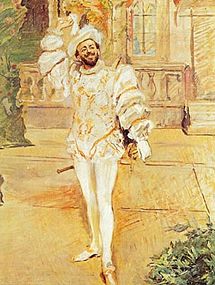Francisco D'Andrade
Francisco D'Andrade | |
|---|---|
 D'Andrade in 1890 as Don Giovanni, his signature role | |
| Born | Francisco Augusto D'Andrade e Silva 11 January 1856 Lisbon, Portugal |
| Died | 8 February 1921 (aged 65) Berlin, Germany |
| Known for | Opera singer (baritone) |
Francisco Augusto D'Andrade, or De Andrade, (11 January 1856 – 8 February 1921)
Life and career
D'Andrade was born in Lisbon. His father was a prominent jurist there, and he initially trained as a lawyer. However, like his older brother António, D'Andrade also had a keen interest in opera and theatre. Both frequently attended performances in the Teatro do Ginásio and participated in amateur productions with the Sociedade Taborda. He studied the basics of acting and music with Manuel Carreira and Arturo Pontecchi, the principal conductor of the Teatro São Carlos, and gave his first public recital in 1879 at the Salão da Trindade in Lisbon. In the spring of 1881, he left for Milan to continue his musical training, first with the tenor Corrado Miraglia, and after Miraglia's death later that year with the baritone Sebastiano Ronconi.[2]
D'Andrade made his operatic debut on 23 December 1882 at the Teatro Principe Amedeo in

D'Andrade began a five-year association with the
Although he continued to tour Europe as a guest singer and recitalist, D'Andrade spent his later career primarily based in Germany, where in 1894, he received the Grand Gold Medal of Arts and Sciences from
D'Andrade moved back to Lisbon during World War I, but returned to Germany and the Hofoper after the war ended in 1918. He retired from the stage in 1919 and died in Berlin two years later at the age of 65. His body was taken back to Lisbon, where he was buried in the family tomb. He was survived by his wife, the Austrian pianist and singer Irma Noethig, whom he had married in 1900, and their son Francisco António Luís de Andrade. His widow later returned to Vienna, where she died in 1937.[1][2]
Portraits by Max Slevogt
A portrait of D'Andrade as Don Giovanni painted by Max Slevogt in 1912 hangs in the Alte Nationalgalerie in Berlin. Also known as Der rote D'Andrade ("The Red D'Andrade"), it depicts the graveyard scene in act 2 of the opera where Don Giovanni taunts the statue of the dead Commendatore and invites him to dinner. It was the last of three large scale oil portraits which Slevoght had painted of D'Andrade in different aspects of the role.[5] The first of these, Der weiße D'Andrade ("The White D'Andrade") painted in 1902, depicts D'Andrade singing the "Champagne Aria" from act 1. It was an immediate success at the 1902 Berlin Secession Exhibition and marked Slevogt as a major exponent of German Impressionism.[6][7] Der schwarze D'Andrade ("The Black D'Andrade") painted in 1903 depicts the final scene of the opera where the white marble hand of the Commendatore summons Don Giovanni to hell.[8]
-
Der weiße D'Andrade ("The White D'Andrade") 1902
-
Der schwarze D'Andrade ("The Black D'Andrade") 1903
-
Der rote D'Andrade
("The Red D'Andrade") 1912
The young Max Slevogt first encountered D'Andrade in 1894 when he was captivated by his triumphant performance as Don Giovanni in Munich. It was the beginning of Slevogt's fascination with Mozart and particularly Don Giovanni. It was also the beginning of a friendship with D'Andrade that would last until the singer's death. When D'Andrade died suddenly in 1921, Slevogt rushed to his house to paint him one last time, but was so overcome by the sight of his dead friend that he was unable do so. Only later did he create a sketch of the coffin from memory entitled Grablegung Don Giovannis ("The burial of Don Giovanni").[5][7]
Recordings
D'Andrade made several recordings for the Lyrophon label in 1906, including the "Champagne Aria" from Don Giovanni which was later reissued on
Notes
- ^ Although many sources still give the birth year as 1859, Mario Moreau in his Cantores de Ópera Portugueses (Bertrand 1981) established it as 1856 on the basis of documents in the possession of D'Andrade's son. See Bispo (February 2007).
- ^ Prior to 1920, the festival was held by the International Mozarteum Foundation.
References
- ^ a b c d Forbes, Elizabeth (2008). "D'Andrade (De Andrade), Francisco in Laura Williams Macy (ed). The Grove Book of Opera Singers, p. 109. Oxford University Press
- ^ a b c d Bispo, A. A. (February 2007). "Francisco de Andrade (1856–1921): Colóquio interdisciplinar pelos 150 anos de nascimento de Francisco de Andrade". Revista Brasil-Europa, Issue 106. Retrieved 10 January 2014 (in Portuguese)
- ^ Casaglia, Gherardo (2005). "Performances by D'Andrade". L'Almanacco di Gherardo Casaglia (in Italian).
- ^ Servizio Bibliotecario Nazionale (Venezia). Library record: Document VEA1198767T. Retrieved 11 January 2014 (in Italian).
- ^ a b Wesenberg, Angelika. "Description: Der Sänger Francisco d'Andrade als Don Giovanni in Mozarts Oper. Staatliche Museen zu Berlin. Retrieved 11 January 2014 (in German).
- ^ Becker, Christoph. Max Slevogt (1868–1932): Das Champagnerlied (Der Weiße d'Andrade) Archived 2015-01-11 at the Wayback Machine. Staatsgalerie Stuttgart. Retrieved 11 January 2014 (in German).
- ^ a b C.A.B.-Artis (20 February 2014). "Landesmuseum Mainz: Slevogts prickelndes Champagnerlied". Brikada – Magazin für Frauen. Retrieved 11 January 2014 (in German).
- ^ Fehlemann, Sabine; Hartje, Nicole (2005). Max Slevogt, die Berliner Jahre, p. 160. Wienand
- ^ Kutsch, Karl-Josef and Riemens, Leo (2003). "D'Andrade, Francisco". Großes Sängerlexikon, Vol. 4, pp. 1001–1002. Walter de Gruyter (in German)
- OCLC 3967289
- OCLC 310780751for the CD edition.



